Kimberly-Clark makes flushable wipes under the Cottonelle® and Scott® brands that are safe to be flushed. These innovative products are engineered to rapidly lose strength as soon as they are flushed.
Cottonelle® and Scott® flushable wipes use our patented SafeFlush Technology*, which allows them to be durable for wiping, and to break up after flushing. Kimberly-Clark flushable wipes exceed the requirements of widely accepted industry guidelines for flushability and will clear properly functioning toilets and drain-lines, and are compatible with sewers, pumps, and septic and municipal treatment systems. That why we confidently stand by our flushability claims.
However, we also make Huggies® baby wipes and Kleenex® wet wipes that are not flushable and carry a prominent Do Not Flush logo. Kimberly-Clark is committed to helping consumers understand what is – and is not – safe to flush. Please read the label on all wipe products and dispose of as directed.
COMMON QUESTIONS ABOUT FLUSHABLE WIPES
How many kinds of flushable wipes does Kimberly-Clark make?
Kimberly-Clark produces flushable wipes under the Cottonelle® and Scott® brands.
What are the materials that make up Kimberly-Clark flushable wipes?
Kimberly-Clark uses 100% FSC certified wood pulp fibers with our proprietary binder that enables the wipe to break up after flushing. The wipes are pre-moistened with a water-based solution to deliver superb cleaning.
Will Kimberly-Clark flushable wipes break down in septic systems?
Yes, Kimberly-Clark flushable wipes are designed to safely breakdown in home septic systems.
Has Kimberly-Clark worked directly with any municipalities to understand their concerns about wipes?
Yes. Through our work together, Kimberly-Clark and wastewater treatment professionals have determined that approximately 98% of materials found in sewer systems is not designed to be flushed.
Do you believe that Kimberly-Clark flushable products are causing problems with clogged municipal sewers?
No. Collaboration between Industry and Wastewater agencies continues to identify that approximately 98% of all materials found in sewers is not designed to be flushed.
Should baby wipes ever be flushed?
No, baby wipes should never be flushed; they should always be disposed of in the trash. In fact, Kimberly-Clark’s Huggies® Baby Wipes are clearly labeled with a “Do Not Flush” logo and should not be flushed.
Baby wipes are made using technology and materials designed to deliver durability, softness and performance which requires them to always be disposed of into the trash and not to be flushed. Consumers should always read the labels on our wipes products to determine whether they are flushable or non-flushable.
How are you educating consumers about what can be flushed?
We want consumers to read the labels on our wipes products before they flush. Don’t flush anything that’s not clearly labeled as safe for flushing. If consumers have additional questions, they can call 1-888-525-8388, Monday through Friday, 8 a.m. to 4 p.m. Central Time. Additionally, consumers can access information on our brand sites at
Cottonelle Flushable Wipes, Scott Flushable Wipes and Huggies® Baby Wipes.
Have you tested the flushability of both toilet paper and flushable wipes together?
Yes, the Toilet and Drain-Line assessment used for our flushable wipes is based on consumer habits and practices and uses toilet paper and flushable wipes together.
How many wipes should someone flush at a time? Is this on the package?
Kimberly-Clark recommends flushing 1‒2 wipes per flush. This instruction appears on all our packages of flushable wipes.
Do your flushable wipes contain alcohol, soaps or oils?
No.
Do your flushable wipes contain antibacterial chemicals or components?
Our flushable wipes are not formulated to be “antibacterial wipes”. However, they do contain preservatives that help keep us safe by reducing the ability of bacteria, yeast, or mold to grow.
How long will your flushable wipes stay moist in the package?
The shelf life for an unopened package of Kimberly-Clark flushable wipes is approximately two years.
What are the tests that you put wipes through to ensure flushability?
The 4th Edition of the INDA/EDANA Guidance Document for assessing the Flushability of Nonwovens
requires that seven rigorous tests must be passed to make a flushable claim.The seven tests are:
- FG501 Toilet and Drain-Line Clearance: Determines the likelihood that a product will be compatible with properly maintained toilets and plumbing systems and should transport satisfactorily in larger sewage conveyance systems.
- FG502 Slosh Box Disintegration Test: Assesses the potential for a product to disintegrate (or break up) when it is subjected to mechanical agitation in water.
- FG503 Household Pump Test: Assesses the compatibility of a product with household sewage ejector pump systems to ensure that the product does not clog, accumulate within or otherwise interfere with normal system operation under high usage conditions.
- FG504 Settling Test: Assesses whether a product will settle in sumps, septic tanks, onsite aerobic systems and settling chambers that are associated with pump stations and municipal wastewater treatment plants.
- FG505 Aerobic Biodisintegration: Assesses the potential for a product to biologically disintegrate under typical conditions found in municipal and onsite wastewater treatment systems.
- FG506 Anaerobic Biodisintegration: Assesses the potential for a product to biologically disintegrate under typical conditions found in municipal and onsite wastewater treatment systems.
- FG507 Municipal Pump Test: Assesses the compatibility of products with municipal sewage pumping systems.










